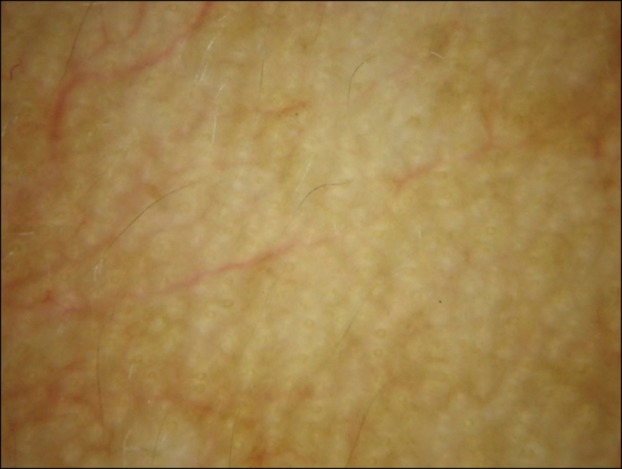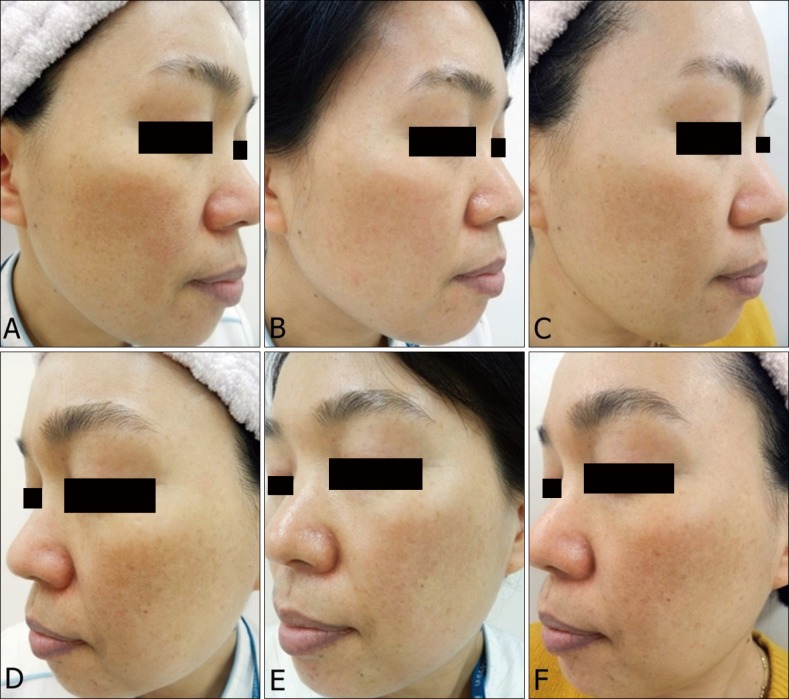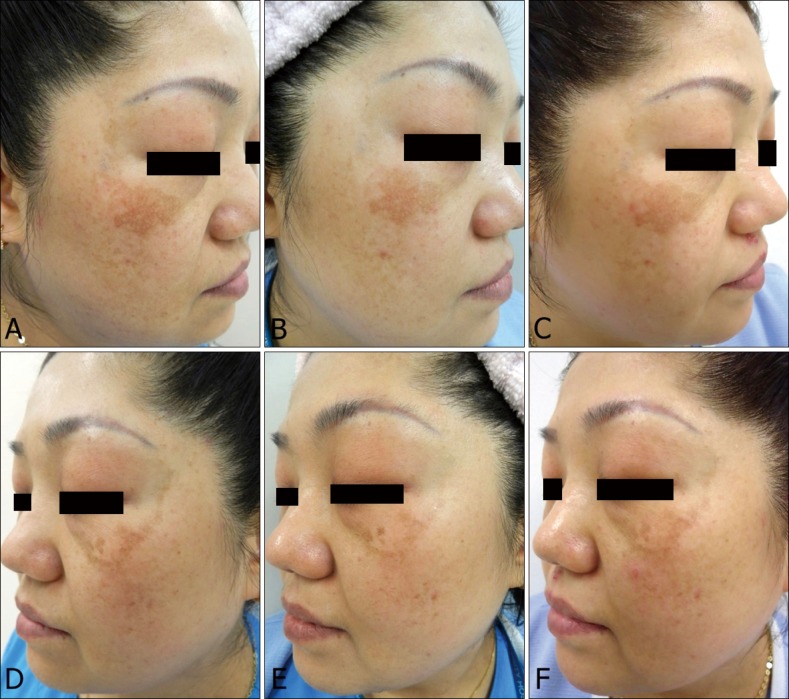Ann Dermatol.
2018 Feb;30(1):1-7. 10.5021/ad.2018.30.1.1.
Treatment of Melasma with Pulsed-Dye Laser and 1,064-nm Q-Switched Nd:YAG Laser: A Split-Face Study
- Affiliations
-
- 1Department of Dermatology, Ulsan University Hospital, University of Ulsan College of Medicine, Ulsan, Korea. uuhderma@daum.net
- KMID: 2399747
- DOI: http://doi.org/10.5021/ad.2018.30.1.1
Abstract
- BACKGROUND
Melasma is an acquired pigmentary disorder that is often therapeutically challenging. Recent evidence suggests that vascular abnormalities are involved in melasma pathogenesis. Pulsed-dye laser (PDL) is considered as standard therapy for vascular lesions.
OBJECTIVE
To assess the efficacy of PDL combined with low-fluence Q-switched Nd:YAG laser (QSNY) in the treatment of melasma.
METHODS
Seventeen melasma patients were enrolled in this study. All subjects were treated with a total of nine QSNY treatment sessions at one-week intervals. Three sessions of PDL were additionally performed immediately after QSNY treatment on the half of the face at baseline, week 4, and week 8. The melasma area and the severity index (MASI) score was calculated at the baseline, one week after the last treatment (week 9), as well as at the follow-up 8 weeks after the last treatment (week 16). Dermoscopic images at the baseline were classified as to whether the visibly widened capillaries were detected or not.
RESULTS
MASI scores on the PDL+QSNY and QSNY side decreased significantly during the study period. There was no significant difference in the MASI score change between both sides in all periods. However, seven patients who had visibly widened capillaries on dermoscopy showed significant difference in both sides in terms of changes in the MASI score during treatment.
CONCLUSION
PDL combined with QSNY may be considered as a safe and effective treatment for melasma patients who show visibly widened capillaries on dermoscopy.
Keyword
Figure
Reference
-
1. Grimes PE. Melasma. Etiologic and therapeutic considerations. Arch Dermatol. 1995; 131:1453–1457. PMID: 7492140.
Article2. Cho SB, Kim JS, Kim MJ. Melasma treatment in Korean women using a 1064-nm Q-switched Nd:YAG laser with low pulse energy. Clin Exp Dermatol. 2009; 34:e847–e850. PMID: 19817757.
Article3. Wattanakrai P, Mornchan R, Eimpunth S. Low-fluence Q-switched neodymium-doped yttrium aluminum garnet (1,064 nm) laser for the treatment of facial melasma in Asians. Dermatol Surg. 2010; 36:76–87. PMID: 20298254.
Article4. Chan NP, Ho SG, Shek SY, Yeung CK, Chan HH. A case series of facial depigmentation associated with low fluence Q-switched 1,064 nm Nd:YAG laser for skin rejuvenation and melasma. Lasers Surg Med. 2010; 42:712–719. PMID: 20848553.5. Kim EH, Kim YC, Lee ES, Kang HY. The vascular characteristics of melasma. J Dermatol Sci. 2007; 46:111–116. PMID: 17363223.
Article6. Kim EJ, Park HY, Yaar M, Gilchrest BA. Modulation of vascular endothelial growth factor receptors in melanocytes. Exp Dermatol. 2005; 14:625–633. PMID: 16026585.
Article7. Geddes ER, Stout AB, Friedman PM. Long-pulsed dye laser of 595 nm in combination with pigment-specific modalities for a patient exhibiting increased vascularity within lesions of melasma. Dermatol Surg. 2016; 42:556–559. PMID: 26963145.
Article8. Lee HI, Lim YY, Kim BJ, Kim MN, Min HJ, Hwang JH, et al. Clinicopathologic efficacy of copper bromide plus/yellow laser (578 nm with 511 nm) for treatment of melasma in Asian patients. Dermatol Surg. 2010; 36:885–893. PMID: 20482724.
Article9. Passeron T. Long-lasting effect of vascular targeted therapy of melasma. J Am Acad Dermatol. 2013; 69:e141–e142. PMID: 23957991.
Article10. Passeron T, Fontas E, Kang HY, Bahadoran P, Lacour JP, Ortonne JP. Melasma treatment with pulsed-dye laser and triple combination cream: a prospective, randomized, single-blind, split-face study. Arch Dermatol. 2011; 147:1106–1108. PMID: 21931054.
Article11. Na JI, Choi SY, Yang SH, Choi HR, Kang HY, Park KC. Effect of tranexamic acid on melasma: a clinical trial with histological evaluation. J Eur Acad Dermatol Venereol. 2013; 27:1035–1039. PMID: 22329442.
Article12. Grimes PE. The safety and efficacy of salicylic acid chemical peels in darker racial-ethnic groups. Dermatol Surg. 1999; 25:18–22. PMID: 9935087.
Article13. Pathak MA, Fitzpatrick TB, Kraus EW. Usefulness of retinoic acid in the treatment of melasma. J Am Acad Dermatol. 1986; 15:894–899. PMID: 3534025.
Article14. Mun JY, Jeong SY, Kim JH, Han SS, Kim IH. A low fluence Q-switched Nd:YAG laser modifies the 3D structure of melanocyte and ultrastructure of melanosome by subcellular-selective photothermolysis. J Electron Microsc (Tokyo). 2011; 60:11–18. PMID: 20937709.
Article15. Kim JH, Kim H, Park HC, Kim IH. Subcellular selective photothermolysis of melanosomes in adult zebrafish skin following 1064-nm Q-switched Nd:YAG laser irradiation. J Invest Dermatol. 2010; 130:2333–2335. PMID: 20463692.
Article
- Full Text Links
- Actions
-
Cited
- CITED
-
- Close
- Share
- Similar articles
-
- Effective Treatment of Suspicious Riehl's Melanosis Using Low Fluence 1,064 nm Q-switched Nd:YAG Laser and 595 nm Pulsed Dye Laser
- Split-face Comparison of Pulse-in-pulse Type Intense Pulsed Light Versus Low-fluence Multi-pass 1064 nm Q-switched Nd:YAG Laser in the Treatment of Facial Melasma
- Treatment of Melasma with the Photoacoustic Twin Pulse Mode of Low-Fluence 1,064 nm Q-Switched Nd:YAG Laser
- Clinical Experience in the Treatment of Port-Wine Stains with Blebs
- A Face-Split Study to Evaluate the Effects of Microneedle Radiofrequency with Q-Switched Nd:YAG Laser for the Treatment of Melasma





